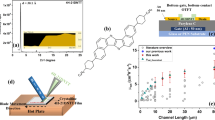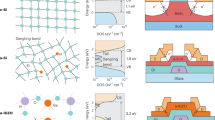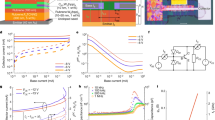Abstract
Organic thin film transistors (TFTs) are of interest for a variety of large-area electronic applications, such as displays1,2,3, sensors4,5 and electronic barcodes6,7,8. One of the key problems with existing organic TFTs is their large operating voltage, which often exceeds 20 V. This is due to poor capacitive coupling through relatively thick gate dielectric layers: these dielectrics are usually either inorganic oxides or nitrides2,3,4,5,6,7,8, or insulating polymers9, and are often thicker than 100 nm to minimize gate leakage currents. Here we demonstrate a manufacturing process for TFTs with a 2.5-nm-thick molecular self-assembled monolayer (SAM) gate dielectric and a high-mobility organic semiconductor (pentacene). These TFTs operate with supply voltages of less than 2 V, yet have gate currents that are lower than those of advanced silicon field-effect transistors with SiO2 dielectrics. These results should therefore increase the prospects of using organic TFTs in low-power applications (such as portable devices). Moreover, molecular SAMs may even be of interest for advanced silicon transistors where the continued reduction in dielectric thickness leads to ever greater gate leakage and power dissipation.
This is a preview of subscription content, access via your institution
Access options
Subscribe to this journal
Receive 51 print issues and online access
$199.00 per year
only $3.90 per issue
Buy this article
- Purchase on Springer Link
- Instant access to full article PDF
Prices may be subject to local taxes which are calculated during checkout



Similar content being viewed by others
References
Rogers, J. A. et al. Paper-like electronic displays: Large-area rubber-stamped plastic sheets of electronics and microencapsulated electrophoretic inks. Proc. Natl Acad. Sci. USA 98, 4835–4840 (2001)
Sheraw, C. D. et al. Organic thin-film transistor-driven polymer-dispersed liquid crystal displays on flexible polymeric substrates. Appl. Phys. Lett. 80, 1088–1090 (2002)
Huitema, H. E. A. et al. Plastic transistors in active-matrix displays. Nature 414, 599 (2001)
Crone, B. K. et al. Organic oscillator and adaptive amplifier circuits for chemical vapor sensing. J. Appl. Phys. 91, 10140–10146 (2001)
Bartic, C., Campitelli, A. & Borghs, G. Field-effect detection of chemical species with hybrid organic/inorganic transistors. Appl. Phys. Lett. 82, 475–477 (2003)
Crone, B. et al. Large-scale complementary integrated circuits based on organic transistors. Nature 403, 521–523 (2000)
de Leeuw, D. M. et al. Polymeric integrated circuits: fabrication and first characterisation. 2002 Int. Electron Device Meeting (IEDM) Tech. Dig., 293–296 (2002)
Baude, P. et al. Pentacene-based radio-frequency identification circuitry. Appl. Phys. Lett. 82, 3964–3966 (2003)
Klauk, H. et al. Pentacene organic transistors and ring oscillators on glass and on flexible polymeric substrates. Appl. Phys. Lett. 82, 4175–4177 (2003)
Collet, J., Tharaud, O., Chapoton, A. & Vuillaume, D. Low-voltage, 30 nm channel length, organic transistors with a self-assembled monolayer as gate insulating films. Appl. Phys. Lett. 76, 1941–1943 (2000)
Boulas, C., Davidovits, J. V., Rondelez, F. & Vuillaume, D. Suppression of charge carrier tunneling through organic self-assembled monolayers. Phys. Rev. Lett. 76, 4797–4800 (1996)
Collet, J. & Vuillaume, D. Nano-field effect transistor with an organic self-assembled monolayer as gate insulator. Appl. Phys. Lett. 73, 2681–2683 (1998)
Schütz, M. Self-Assembled Monolayers on Oxidized Surfaces—Anti-Corrosion and Insulation Behavior PhD thesis, 192–193, Univ. Stuttgart (2002)
Lenfant, S., Krzeminski, C., Delerue, C., Allan, G. & Vuillaume, D. Molecular rectifying diodes from self-assembly on silicon. Nano Lett. 3, 741–746 (2003)
Kelley, T. W. et al. High-performance OTFTs using surface-modified alumina dielectrics. J. Phys. Chem. B 107, 5877–5881 (2003)
Klauk, H. et al. High-mobility polymer gate dielectric pentacene thin film transistors. J. Appl. Phys. 92, 5259–5263 (2002)
Halik, M. et al. Relationship between molecular structure and electrical performance of oligothiophene organic thin film transistors. Adv. Mater. 15, 917–922 (2003)
Kelly, T. W. et al. High performance organic thin film transistors. MRS Symp. Proc. 771, 169–179 (2003)
Fontaine, P. et al. Octadecyltrichlorosilane monolayers as ultrathin gate insulating films in metal-insulator-semiconductor devices. Appl. Phys. Lett. 62, 2256–2258 (1993)
Thompson, S. et al. A 90 nm logic technology featuring 50 nm strained silicon channel transistors, 7 layers of Cu interconnects, low k ILD, and 1 µm2 SRAM cell. 2002 Int. Electron Device Meeting (IEDM) Tech. Dig., 61–64 (2002)
Sekine, K., Saito, Y., Hirayama, M. & Ohmi, T. Highly reliable ultrathin silicon oxide film formation at low temperature by oxygen radical generated in high-density krypton plasma. IEEE Trans. Electr. Dev. 48, 1550–1555 (2000)
Lo, S. H., Buchanan, D. A., Taur, Y. & Wang, W. Quantum-mechanical modeling of electron tunneling current from the inversion layer of ultra-thin-oxide nMOSFETs. IEEE Electr. Dev. Lett. 18, 209–211 (1997)
Acknowledgements
M.S. and S.M. were supported by the PhD Fellowship of the Deutsche Forschungsgemeinschaft.
Author information
Authors and Affiliations
Corresponding author
Ethics declarations
Competing interests
The authors declare that they have no competing financial interests.
Supplementary information
Supplementary Figure S1
Tapping mode AFM height and phase images. (DOC 207 kb)
Supplementary Figure S2
STM images of a PhO-OTS monolayer. (DOC 600 kb)
Supplementary Figure S3
Electrical characteristics of an Eth-6T-Eth TFT with PhO-OTS gate dielectric. (DOC 43 kb)
Rights and permissions
About this article
Cite this article
Halik, M., Klauk, H., Zschieschang, U. et al. Low-voltage organic transistors with an amorphous molecular gate dielectric. Nature 431, 963–966 (2004). https://doi.org/10.1038/nature02987
Received:
Accepted:
Issue Date:
DOI: https://doi.org/10.1038/nature02987
This article is cited by
-
Detailed Investigation of Plasticized PMMA Dielectric for Improved Performance of Organic Field-Effect Transistors
Journal of Electronic Materials (2024)
-
Recent development of E-field control of interfacial magnetism in multiferroic heterostructures
Nano Research (2023)
-
Two-dimensional covalent organic framework films prepared on various substrates through vapor induced conversion
Nature Communications (2022)
-
Improving bias-stress stability of p-type organic field-effect transistors by suppressing electron injection
Journal of Materials Science: Materials in Electronics (2022)
-
Aluminum Oxide/Fluoride Self-Assembled Monolayer Double Gate Dielectric for Solution-Processed Indium Oxide Thin-Film Transistors
Electronic Materials Letters (2022)
Comments
By submitting a comment you agree to abide by our Terms and Community Guidelines. If you find something abusive or that does not comply with our terms or guidelines please flag it as inappropriate.



